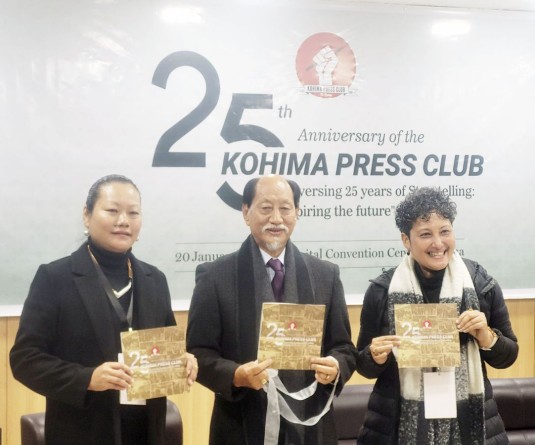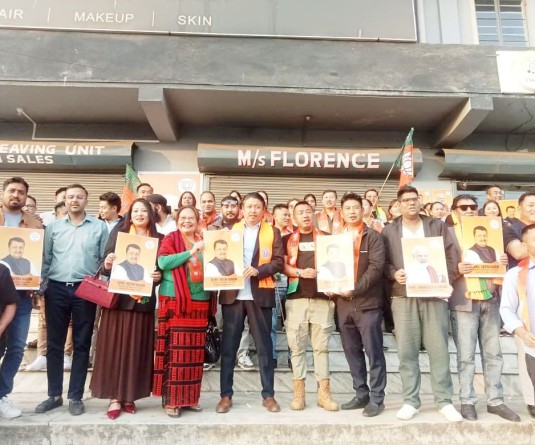Delegates at the 51st Commercial Coordination Committee Meeting of the North Eastern Regional Power Committee (NERPC) hosted by the DoPN in Chümoukedima.
Fiscal 2023-24 saw 300 crore in return against 540 crore in purchase
Morung Express News
Dimapur | April 26
When it comes to electricity, the emphasis largely revolves around supply shortfall owing to alleged deficient generation at the generating stations in the northeastern region. It is either blamed on nature or technical issues.
In the event, the power generating stations start producing to its maximum capacity, flooding the supply grid with surplus electricity, does Nagaland has the distribution infrastructure to sustain the prevailing peak demand? This was a question posed to the Engineer-in-Chief (E-in-C), Department of Power Nagaland (DoPN) during a media interaction on the sideline of a programme on April 26.
Unfortunately, the answer was in the negative. The programme happened to be the 51st Commercial Coordination Committee Meeting of the North Eastern Regional Power Committee (NERPC) hosted by the DoPN in Chümoukedima.
According to Moa Aier, DoPN E-in-C, Nagaland does not have the distribution infrastructure or capacity to meet an approximated peak demand tipped at 180-200 MW at present. The prevailing power distribution capacity was said to be barely a half (or 90 MW) of the peak demand. “Beyond that, even if power is available on the grid, we cannot distribute because our distribution system doesn't have the strength,” said Aier.
Distribution transformers conking out, especially during the summer in Dimapur and Chümoukedima, are annually recurring events. This, in part, provides a peak into Nagaland’s weak power distribution set up.
He said that transformers in the 63, 100 or 250 kVA ranges are not supposed to be loaded beyond 70-80 percent of its rated capacity. However, he claimed that the department is compelled to do so during the peak hours resulting in burn-outs. It further gives rise to the problem of finding replacements, which often takes days, if not weeks. He added that scarce spare distribution transformers imply longer waiting periods.
Purchase-Revenue gap
On the revenue side of things, the DoPN is not faring well either. The 2023-24 fiscal saw the department recovering only a half of the purchase cost. Aier disclosed that Nagaland spent Rs 540 cr on purchasing electricity and in return could collect only Rs 293 cr as revenue from the consumers. While he said that the department has been trying to improve, he added that the purchase-revenue gap has remained largely constant over the years.
Power and poor revenue, according to him, has almost become a social issue in Nagaland, a place where the consumers oppose transitioning to prepaid metering, which is imagined as a means to ease the revenue burden.
Proposed power plants
The State Government has announced a slew of power generating projects over the years, including a 20 MW solar plant in Ganeshnagar by Halo Energie Pvt Ltd and a 27 MW thermal plant in Tuli by Fitzroy Energy and Minerals Ltd.
Two years since the State Government signed a Power Purchase Agreement with Halo Energie, the latter has yet to start activity on the ground, according to the Chief engineer (Transmission & Generation), Penrithung Yanthan. He disclosed that the state government is contemplating terminating the PPA. Ground activities were set to be on for the thermal plant in Tuli.
NERPC serves as a facilitator
As conferred by the Electricity Act, the NERPC serves as a facilitator for “integrated operation of the power system in the region including inter-state/inter-regional transfer of power among others.” Through its various sub-committees, it addresses issues affecting the state power utilities vis-à-vis power purchase, power scheduling, energy accounting, tariff and regulatory aspects. Its members include personnel from the state DISCOMs (distribution companies/departments) and generating and transmission firms.
NERPC Member Secretary KP Jagtap said that the NERPC also settles disputes, including financial or payment disputes, which may arise among the generating stations, consumers and DISCOMs.
According to him, at present, the selling rate of a unit of hydro energy ranges from Rs 1-3, while it is around Rs 5 for energy generated by thermal plants.
The peak demand of the NE region in 2023 was said to be 3,662 MW against availability peaking at around 3600-3700 MW. Jagtap stressed on “resource adequacy” by means of building more generating stations, while inking long-term power purchase deals for stable power supply.





